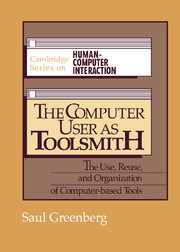Book contents
- Frontmatter
- Contents
- List of figures
- List of tables
- Foreword
- Acknowledgments and dedication
- 1 Introduction
- 2 Studying UNIX
- 3 Using commands in UNIX
- 4 Techniques for reusing activities
- 5 Recurrent systems
- 6 Reuse opportunities in UNIX csh – potential and actual
- 7 Principles, corroboration, and justification
- 8 Organizing activities through workspaces
- 9 A workspace system: description and issues
- 10 Conclusion
- Appendix A A sample trace
- Appendix B Summary statistics for each subject
- References
- Author index
- Subject index
3 - Using commands in UNIX
Published online by Cambridge University Press: 26 May 2010
- Frontmatter
- Contents
- List of figures
- List of tables
- Foreword
- Acknowledgments and dedication
- 1 Introduction
- 2 Studying UNIX
- 3 Using commands in UNIX
- 4 Techniques for reusing activities
- 5 Recurrent systems
- 6 Reuse opportunities in UNIX csh – potential and actual
- 7 Principles, corroboration, and justification
- 8 Organizing activities through workspaces
- 9 A workspace system: description and issues
- 10 Conclusion
- Appendix A A sample trace
- Appendix B Summary statistics for each subject
- References
- Author index
- Subject index
Summary
This chapter examines how people use commands in command-based systems. Like previous work, it is based on an analysis of long-term records of user–computer interaction with the UNIX csh command interpreter, collected as described in the previous chapter. The results of the major studies are reevaluated, particularly those of Hanson, Kraut, and Farber (1984), and Draper (1984), and some of the work is replicated. Although the statistical results of the studies are supported, some of the conclusions made by the original researchers are found to be misleading.
The following sections provide details of how people direct command-based systems in terms of how individual commands are selected and the dependencies between these commands. It is essential to take into account the fact that pooled statistics may conceal important differences between individuals. As a consequence, the results are analyzed by user and by identifying groups of similar users, as well as by pooling data for the entire population.
For the current study, a command is the first word entered in the command line. Those lines that produced system errors were not considered. The first word is parsed by removing all white space at the beginning of the line and counting all characters up to but not including the next white space or end of line. For example, the command parsed from the command line
print −f 31 −t 40 galley.text
is “print.” The parsed word is almost always a true UNIX command or alias that invokes a program or shell script.
- Type
- Chapter
- Information
- The Computer User as ToolsmithThe Use, Reuse and Organization of Computer-Based Tools, pp. 26 - 39Publisher: Cambridge University PressPrint publication year: 1993

